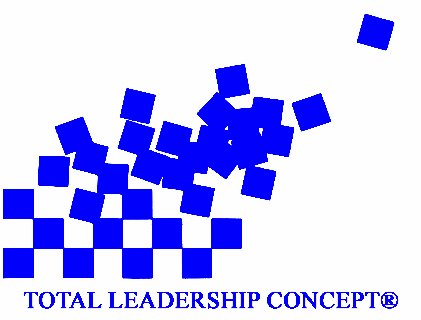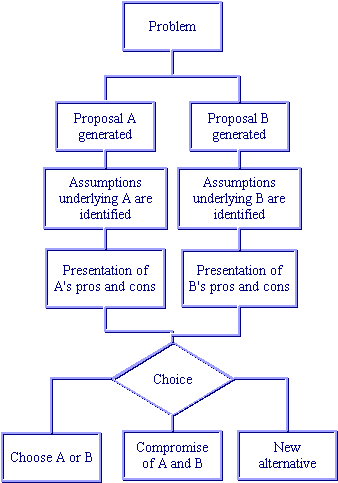
Abilities
Arousal
Attitude
Behavior
Beliefs
Competencies
Engagement
Environment
EI
Experience
Feelings
Intention
Motivation
Nature and genes
Organization
Performance
Performance Improvement
Performers
Process
Results
Skills
Social Pressure
Talent
Understanding
Values
What is Brainstorming?
Brainstorming is a process for developing creative solutions to problems. It works by focusing on a problem, and then deliberately coming up with as many solutions as possible and by pushing the ideas as far as possible. One of the reasons it is so effective is that the brainstormers not only come up with new ideas in a session, but also spark off from associations with other people's ideas by developing and refining them.
The steps for brainstorming are:
1. Gather the participants from as wide a range of disciplines with as broad a range of experience as possible. This brings many more creative ideas to the session.
2. Write down a brief description of the problem - the leader should take control of the session, initially defining the problem to be solved with any criteria that must be met, and then keeping the session on course.
3. Use the description to get everyone's mind clear of what the problem is and post it where it can be seen. This helps in keeping the group focused.
4. Encourage an enthusiastic, uncritical attitude among brainstormers and encourage participation by all members of the team. Encourage them to have fun!
5. Write down all the solutions that come to mind (even ribald ones). Do not interpret the idea, however you may rework the wording for clarity's sake.
6. Do not evaluate ideas until the session moves to the evaluation phase. Once the brainstorming session has been completed, the results of the session can be analyzed and the best solutions can be explored either using further brainstorming or more conventional solutions.
7. Do not
censor any solution, no matter how silly it sounds. The silly ones will
often lead to creative ones - the idea is to open up as many
possibilities as possible, and break down preconceptions about the limits
of the problem.
8. The leader should keep the brainstorming on subject, and should try to steer it towards the development of some practical solutions.
9. Once all the solutions have been written down, evaluate the list to determine the best action to correct the problem.
Brainstorming variations
One approach is to seed the session with a word pulled randomly from a dictionary. This word as a starting point in the process of generating ideas.
When the participants say they "can't think of any more ideas" then give them about 15 more minutes as the best ideas sometimes come towards the end of long thought out thought processes.
Brainstorming can either be carried out by individuals or groups. When done individually, brainstorming tends to produce a wider range of ideas than group brainstorming as individuals are free to explore ideas in their own time without any fear of criticism. On the other hand, groups tend to develop the ideas more effectively due to the wider range of diversity.
Keep all the generated ideas visible. As a flip chart page becomes full, remove it from the pad and tape it to a wall as that it is visible. This "combined recollection" is helpful for creating new ideals.
If the brainstormers
have difficulty in coming up with solutions, you may have to reinstate
the problem.
Selecting a Solution
When you are sure the brainstorming session is over, it is time to select a solution.
By using
a show of hands (or another voting method), allow each person to vote
for as many ideas on the original list as they want. Note that they
only have one vote per generated ideal.
Write the vote tallies next to the ideal. You can use a different color
than the ideal to help it stand out. Once the voting is completed, delete
all items with no votes.
Next, look for logical breaks. For example, if you have several items with 5 or 6 votes, and no 3 or 4 and only a couple of 1 and 2, then retain only the 5 and 6 votes. The group can help to decide the breaking point.
Now, it is time to vote again. Each person gets half number of votes as there are ideals left. For example is you narrowed the number of generated ideals down to 20, then each person gets 10 votes (if it is a odd number, round down). Each person will keep track of his or her votes. The scribe should again tally the votes next to the ideal, only this time use a different color. Continue this process of elimination until you get down to about 5 ideals.
Put the remainder ideas into a matrix. Put each ideal into its own row (first column). Next label some columns using selected criteria. For example:
| Generated Idea | Low
Cost |
Easy
to Implement and is Feasible |
Will
Help Other Processes |
Total |
| Outsource it to a vendor. | - |
- |
- |
- |
| Hire a new employee. | - |
- |
- |
- |
| Share the extra workload. | - |
- |
- |
- |
Next, working one column at a time, ask the group to order each idea. Using the above example, which one will cost the least, the most, and will be in the middle.
Repeat by working the next column until you have completed all columns. Total each column until it looks similar to this:
| Generated Idea | Low
Cost |
Easy
to Implement and is Feasible |
Will
Help Other Processes |
Total |
| Outsource it to a vendor. | 2 |
2 |
2 |
6 |
| Hire a new employee. | 3 |
1 |
1 |
5 |
| Share the extra workload. | 1 |
3 |
3 |
7 |
It this case,
the lowest number column, "Hire a new employee," would be
the best solution.
Note that you should work each column first (not each row). Some of
the columns will require much discussion, as choosing an arbitrary number
will not be that easy in some cases. Often, you will have a couple of
ideas that tie, but having it diagramed out in a matrix makes it much
easier to make a decision.
Delphi Decision Making
In Delphi decision groups, a series of questionnaires are sent to selected respondents (Delphi group). The group does not meet face-to-face. All communication is normally in writing (normally letters or email). Members of the groups are selected because the are experts or they have relevant information. Steps include:
1. Members
are asked to share their assessment and explanation of a problem or
predict a future state of affairs
2. Replies are gathered, summarized, and then fed back to all the group
members.
3. Members then make another decision based upon the new information.
4. The process may be repeated until the the responses converge satisfactory.
The success of this process depends upon the member's expertise and communication skill. Also, each response requires adequate time for reflection and analysis. The major merits of the Delphi process is:
- Elimination
of interpersonal problems.
- Efficient use of expert's time.
- Diversity of ideals.
- Accuracy of solutions and predictions.
Dialectic Decision Making
The dielectric decision method traces its roots back to Socrates and Plato. It helps to overcome such problems as converging too quickly one one solution while overlooking others, participants dislike of meetings, incomplete evaluations, and the failure to confront tough issues. The steps of Dialectic Decision Making are:
1. Issue a clear statement of the problem to be solved.
2. Two or more competing proposals are generated.
3. Members identify the explicit or implicit assumptions that underlie each proposal.
4. The team then breaks into advocacy sub, who examine and argue the relative merits of their positions.
5. The group reassembles and makes a decision:
- embrace
one of the alternatives
- forge a compromise
- generate a new proposal
The process looks like this:

This process
helps the members to better understand the proposals along with their
pros and cons. The main disadvantage is the tendency to forge a compromise
in order to avoid choosing sides.